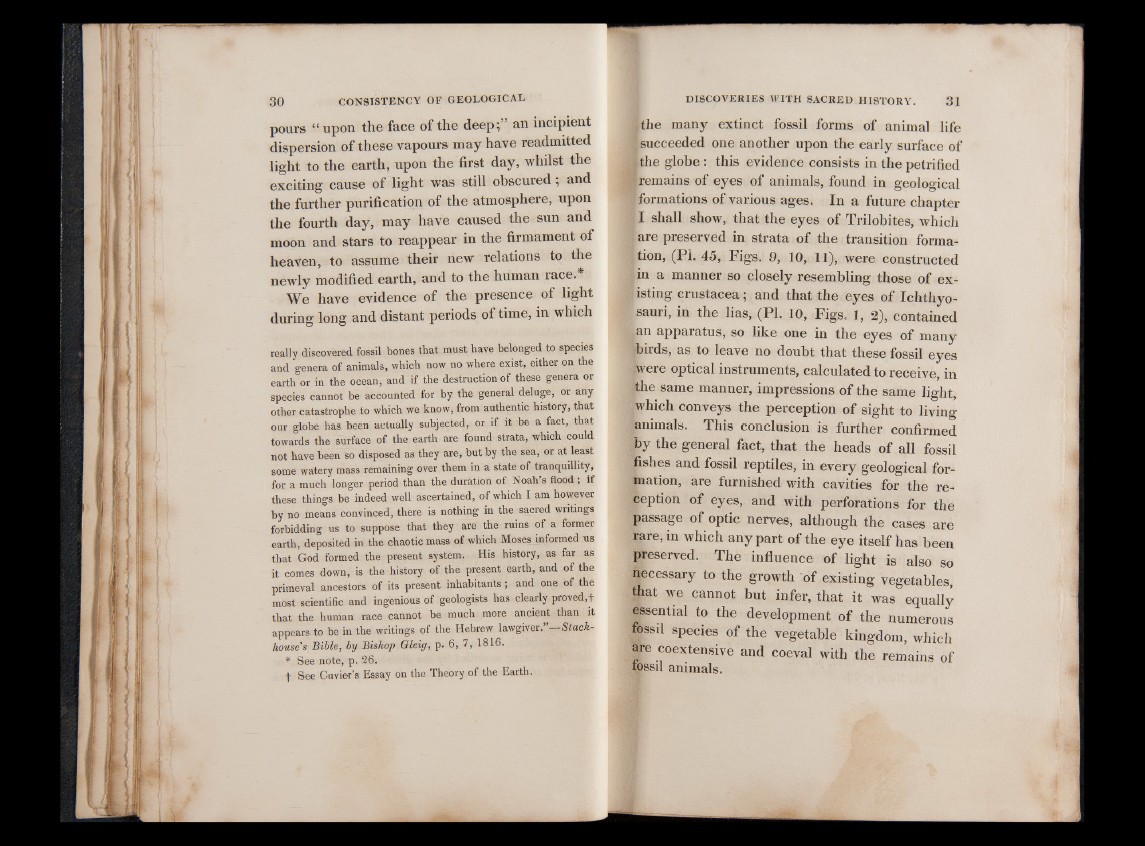
pours “ upon the face of the deep; an incipient
dispersion of these vapours may have readmitted
light to the earth, upon the first day, whilst the
exciting cause of light was still obscured; and
the further purification of the atmosphere, upon
the fourth day, may have caused the sun and
moon and stars to reappear in the firmament of
heaven, to assume their new relations to the
newly modified earth, and to the human race*
We have evidence of the presence of light
during long and distant periods of time, in which
really discovered fossil bones that must have belonged to species
and genera of animals, which now no where exist, either on the
earth or in the ocean, and if the destruction of these genera or
species cannot be accounted for by the general deluge, or any
other catastrophe to which we know, from authentic history, that
our globe has been actually subjected, or if it be a fact, that
towards the surface of the earth are found strata, which could
not have been so disposed as they are, but by the sea, or at least
some watery mass remaining over them in a state of tranquillity,
for a much longer period than the duration of Noah’s flood ; if
these things be indeed well ascertained, of which I am however
by no means convinced, there is nothing in the sacred writings
forbidding us to suppose that they are the ruins of a former
earth, deposited in the chaotic mass of which Moses informed us
that God formed the present system. His history, as far as
it comes down, is the history of the present earth, and of the
primeval ancestors of its present inhabitants; and one of the
most scientific and ingenious of geologists has clearly proved,f
that the human race cannot be much more ancient than it
appears to be in the writings of the Hebrew lawgiver.” Stack-
house’s Bible, by Bishop Gleig, p. 6, 7, 1816.
* See note, p. 26.
f See Cuvier’s Essay on the Theory of the Earth.
Ithe many extinct fossil forms of animal life
isucceeded one another upon the early surface of
I the globe : this evidence consists in the petrified
iremains of eyes of animals, found in geological
I formations of various ages. In a future chapter
II shall show, that the eyes of Trilobites, which
| are preserved in strata of the transition formation,
(PI. 45, Figs. 9, 10, 11), were constructed
I in a manner so closely resembling those of exit
isting Crustacea; and that the eyes of Ichthyo-
Isauri, in the lias, (PI. 10, Figs. 1, 2), contained
|an apparatus, so like one in the eyes of many
birds, as to leave no doubt that these fossil eyes
were optical instruments, calculated to receive, in
the same manner, impressions of the same light,
which conveys the perception of sight to living
Iknimals. This conclusion is further confirmed
by the general fact, that the heads of all fossil
Ipshes and fossil reptiles, in every geological formation,
are furnished with cavities for the reception
of eyes, and with perforations for the
passage of optic nerves, although the cases are
rare, in which any part of the eye itself has been
preserved. The influence of light is also so
necessary to the growth of existing vegetables,
|jiat we cannot but infer, that it was equally
»sential to the development of the numerous
fossil species of the vegetable kingdom, which
are coextensive and coeval with the remains of
tossil animals.